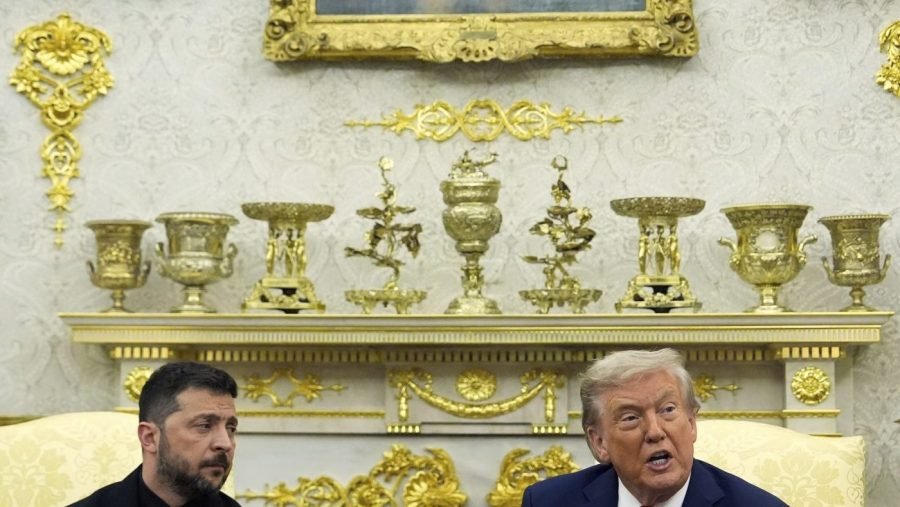
As with most houses, the White House is decorated and renovated to suit the tastes and needs of new occupants. Such changes are usually made without much complaint or controversy.
Not so with the second Trump administration. The renovations have been considerably more dramatic than usual, and the criticisms — both aesthetic and political — more severe.
The Rose Garden was paved over to resemble the patio at Mar-a-Lago, President Trump’s Florida resort. Huge flag poles were erected on the North and South Lawns. A “tacky” Oval Office has been festooned with gilded picture frames, “Rococo mirrors,” moldings and cherubs that resemble (in the estimation of one critic) Cadbury bunnies.
And last, but certainly not least, is Trump’s proposed 90,000-square-foot ballroom to be built off the East Wing (the White House is 55,000 square feet) and designed to suit the president’s penchant for “Dictator Chic.” When asked why this is necessary, Trump explained that “there’s never been a president that was good at ballrooms.” This is probably true.
The administration offers vague assurances that unnamed “private donors” will cover the estimated $200 million cost for the ballroom. Regardless of who picks up the tab (or pays the bribe), the gauche opulence of the White House renovations do not easily align with the administration’s vows to combat wasteful government spending, or its admonitions to Americans to tighten their belts should Trump’s tariffs raise their cost of living. Your children can get by with fewer toys, and this ballroom is going to be spectacular.
But does any of this matter? Has any president ever paid a political price for extravagant White House renovations? I can think of one: Martin Van Buren.
The eighth president lost his bid for reelection in 1840 amidst accusations that he lived in “regal splendor” in the “President’s Palace.” Those accusations, which had little basis in fact, can be traced back to a since forgotten congressional speech then known and celebrated as the “Gold Spoon Oration.”
On April 14, 1840, Whig Rep. Charles Ogle of Pennsylvania took the floor of the House to oppose a $3,665 appropriation for repairs and maintenance to the White House and its grounds. The capital had been abuzz with rumors that a Kentucky congressman had confronted Van Buren over a gold spoon used at a White House dinner. The congressman in question denied the story, and the commissioner of public buildings confirmed that no gold tableware had been purchased during Van Buren’s term.
None of this deterred Ogle from claiming that “golden goblets, table spoons, knives and forks” bedecked the dining tables of the president’s “palace.”
This was only the beginning of three days of adjective-rich speechifying. Ogle led his audience through grounds and gardens cultivated at the public expense to “please the sickly and vicious taste of palace dandies” and on to the “spacious courts, gorgeous banqueting halls, sumptuous drawing rooms” and “glittering and dazzling saloons” of the White House. He produced receipts for French settees and sofas covered in gilt and damask satin, Turkish divans, Japanese trays, Belgian carpeting and 72 “foreign Fanny Kemble green finger cups” for Van Buren to “wash his pretty tapering, soft, white, lily fingers, after dining on fricandeau de veau and omelette souffle.”
Such extravagance, Ogle maintained, offended the “plain, simple, and frugal notions of our republican people,” who would never think of housing “their chief servant in a palace as splendid as that of the Caesars, and as richly adorned as the proudest Asiatic mansion,” where even the most virtuous president might succumb to “sloth and effeminacy.”
Ogle devoted the second day of his oration to an account of the lily-fingered Van Buren’s aristocratic tastes and career of “pretended democracy.” On the third day, he praised the rough-handed frontier virtues of William Henry Harrison, the 1840 Whig presidential nominee, who allegedly preferred the simple comforts of a frontier log cabin to the splendor of a palace, and a tankard of American hard cider to a flute of French champagne.
Whigs made the contrast between Harrison’s log cabin and Van Buren’s palace the focus of their 1840 campaign. Gold Spoon stories resonated with Americans still struggling to recover from the financial panic of 1837and ensuing recession. Whig newspapers and presses printed countless copies of the Gold Spoon oration, occasionally adding new and more fantastical reports of the decadence at 1600 Pennsylvania Avenue.
The strategy worked, and Harrison became president — for a month, before he died, likely of typhoid fever.
Americans today may not regard luxury as inimical to republican virtue in the way that they did in 1840. But prolonged inflation or a recession could reawaken those attitudes. In that context, Trump’s tacky and risible affection for gilded moldings and glitzy ballrooms could become a serious political liability.
The next Gold Spoon oration almost writes itself, and without the “fake news” of the original. ChatGPT could probably do it, but it might be better if a live politician did.
Mark G. Schmeller is an associate professor of history at Syracuse University.


